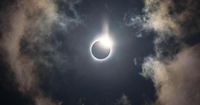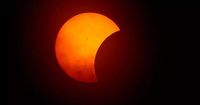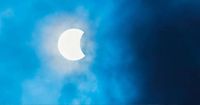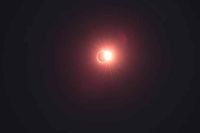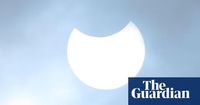On Saturday morning, March 29, 2025, a partial solar eclipse will be visible across the United Kingdom, captivating astronomy enthusiasts and casual observers alike. This celestial event occurs when the Moon passes between the Earth and the Sun, partially blocking the Sun's light. Although it won't be as dramatic as a total solar eclipse, the partial eclipse promises to be a breathtaking sight, with up to 47% of the Sun obscured in some parts of the UK.
The eclipse will begin around 10:00 AM and conclude by noon, with the maximum coverage occurring at approximately 11:03 AM. The Outer Hebrides is expected to provide the best view, where 47% of the Sun will be obscured. Following closely, Northern Ireland will experience 44% coverage, while West Wales will see about 38%. Franck Marchis, an astronomer at the SETI Institute and co-founder of Unistellar, emphasized the beauty of the event, stating, "While it may not be as dramatic as a total solar eclipse, a partial eclipse is still a breathtaking sight, and there are plenty of safe ways to enjoy the experience."
For those hoping to catch a glimpse, several major cities across the UK will experience varying degrees of obscuration. Cardiff will see 34.75% coverage at 10:02 AM, Bristol 33.90% at 10:03 AM, and Southampton 31.53% at 10:04 AM. Birmingham and Liverpool will have 34.33% and 36.99% obscured respectively at 10:05 AM, while London will experience 30.62% coverage at 10:07 AM. Glasgow will have a notable 41.73% obscured at the same time.
However, weather conditions could play a significant role in visibility. The Met Office has indicated that a band of rain is expected to move east across Scotland and Northern Ireland, potentially obscuring views in those regions. In contrast, the forecast for the rest of the UK suggests a largely fine and sunny start, although cloud and patchy rain may develop later in the day. Met Office meteorologist Alex Burkill noted, "The further northwest you are in the UK, the more of an eclipse you are likely to have, whereas towards the southeast it's a little bit less—but still 30 percent, and still a large chunk taken out of the Sun."
Viewing the eclipse safely is crucial. Astronomers strongly advise against looking directly at the Sun, even during an eclipse, as this can result in permanent eye damage. Observers should use solar eclipse glasses that comply with safety standards (ISO 12312-2) or employ indirect viewing methods. Jake Foster from the Royal Observatory Greenwich suggested using a colander or a piece of paper with a small hole to project the image of the eclipse onto a surface. "It’ll look like the Sun is having a bite taken out of it but it’ll be projected so that you can actually safely view it as it happens," he explained.
A partial solar eclipse is a rare event in the UK, and many are looking forward to this spectacle. The last total solar eclipse visible from the UK occurred in 1999, and the next one won't happen until 2090. However, a total solar eclipse is expected to pass over parts of Europe, including Spain, in August 2026, offering another opportunity for enthusiasts.
As excitement builds for the partial solar eclipse, many are preparing for the event. The Royal Observatory Greenwich will be live streaming the eclipse, providing a safe way for the public to experience the phenomenon. This is particularly important for those in areas where weather conditions may hinder visibility.
In summary, the partial solar eclipse on March 29, 2025, offers a unique opportunity for observers across the UK to witness a spectacular celestial event. With varying degrees of coverage depending on location, and with the potential for weather to impact visibility, preparation is key for those eager to catch a glimpse of the Moon's transit across the Sun. As the excitement builds, one thing is certain: this rare event will leave many awestruck by the wonders of our solar system.
